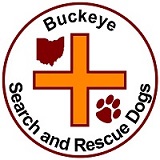
This page gives a “30,000 foot overview” of the process.
Training a search dog often takes a year or more, and by no means should you think a web site, book, or short-term process is sufficient to train a dog and handler to reliable mission-ready status.
If you are truly interested in becoming a search dog handler, our recommendation is that you first do more research. Maybe read some of the books from our suggested reading list. Find a K9-SAR organization in your area and offer to help them by being a trail runner. As you learn more, seek out an experienced K9 Search and Rescue team like BSARD, one of our mutual aid partners, or a similar team in your geographical area that has room to take you on as a trainee. Also search for accredited workshops and seminars to gain more experience.
Getting Started
In our experience, we’ve concluded that the earlier you can begin training your dog for Search and Rescue, the better. This is primarily for two reasons:
- Pups and young dogs are still forming cerebral synapses. Exposure to new stimuli literally “hard-wires” itself into their brains. This results in commands and behaviors becoming deeply ingrained into the dog’s psyche. It also helps the handler “iron out” undesirable or quirky behaviors.
- The younger the dog, the longer the search career. It often takes a year or longer to get a dog and handler up to mission-ready status. Also, age and health issues will ultimately force the dog into retirement. Due to the time and effort involved in training and handling a search dog, a handler naturally wants to get as many working years as possible with their partner.
This is not to say that older dogs cannot still become top-notch search dogs. BSARD alumnus Linda Perry had great success training older dogs, strays, and rescues for SAR work. She had an 8-year-old Rottweiler named Gertie who worked until she was 14, although I think Linda would be the first to admit that it takes a lot of patience and energy.
Early Training
Whether you’re training a puppy or an older dog, the early process is essentially the same:
- Teaching the dog the meaning of the search command.
- Teaching the dog to take scent from an offered scent sample (if the dog is to do scent-specific work).
- Encouraging the dog to rely on their nose to track the scent to its strongest source.
- Teaching the handler to read the dog’s body language.
- Forming a Trained Final Response.
There are many good beginner techniques outlined in some of the books from our suggested reading list. The most important thing is to keep it fun for the dog. If it becomes too much like work, it will be much more difficult to train both your dog and yourself! Also remember, if you’re working with a puppy, their attention span is only a very few minutes before they bore with the “game.” Start with many (daily) very easy but very short (five minutes or so) training sessions. Start very simple. Think of it as “hide-and-seek” with a toddler. As he gets the hang of it you’ll be able to increase the complexity.
Remember that YOU MUST BE CONSISTENT! Don’t jump around between methodologies because it’ll only confuse your dog and frustrate both of you. Over time, you will invariably encounter a situation where one trainer’s teaching methods conflict with another trainer you’ve worked with. When this occurs think of it as two different ways you can perform the same task. You can glue two boards together or you can screw two boards together; neither is intrinsically better (except possibly for the specific task at hand). Keep the glue AND the screwdriver in your tool box and use the method that works best FOR THIS DOG and use it consistently. Maybe the other methods will apply to a different situation or your next dog.
Whatever methodology you use, here are some pointers that in our experience make basic training go a little quicker and smoother:
- When you give the search command to your dog, keep it just something like “find” as opposed to “find Billy.” Remember that your dog has to transfer the idea to unknown persons later on. Also, only say it once.
- After giving the command, it’s best to stay as quiet as possible so the dog can figure out the issues without you interrupting. Don’t say their name while they’re searching. If you feel the overwhelming need to encourage them, use something other than the command like “where is he?” or “keep working.”
- When you arrive at the missing person, make it into a major puppy party with high voices and excited happy expressions. Give the dog the reward that they will ONLY get when they find the correct person. If you are training live find, you may want to let the “missing person” reward the dog.
- As much as possible, use different people and different hiding places. Dogs learn quickly and cheat well.
- WATCH YOUR DOG! TRUST YOUR DOG! The expression we like to use when we start trying to think for the dog (and EVERYBODY falls into that trap from time to time) is “What do YOU smell?”
Advanced Training
Once you and your dog have mastered the basics, it becomes a matter of repetition and practice, along with exposure to new scenarios and increasing complexity. Make sure your scenarios are challenging enough to be interesting for both dog and handler, but also only slightly exceeds the experience of both. If you jump too far ahead and either frustrate your dog or make yourself angry, it can be difficult to regain your momentum.
Another excellent resource are the classes and seminars put on by local, regional, and national SAR organizations, such as NASAR, CSAR, or IPWDA.
